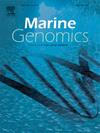Complete genome sequence of the marine mangrove fungus Sarcopodium sp.QM3–1 confirmed its high potential for antimicrobial activity
IF 1.5
4区 生物学
Q4 GENETICS & HEREDITY
引用次数: 0
Abstract
Mangroves, owing to their unique living environment, serve as an important source of natural bioactive compounds. Sarcopodium sp. QM3–1, a marine fungus isolated from mangrove sediments of Quanzhou Bay, exhibited antifungal activity against the plant pathogen Agrobacterium tumefaciens and Magnaporthe oryzae. Whole-genome sequencing of this fungal strain revealed a genome size of 58,356,150 bp with 17,960 protein-coding genes, 539 tRNA genes, and 170 rRNA genes. Functional annotation identified a series of genes involved in the biosynthesis of secondary metabolites, including several gene clusters associated with antimicrobial activity. Notably, twenty of these gene clusters were associated with the synthesis of known bioactive compounds, including terpene, polyketides (PKS), nonribosomal peptides (NRPS), β-lactones, and phosphonates. Our findings suggest that Sarcopodium sp. QM3–1 could be a promising candidate as a biocontrol agent for combating plant pathogens in agricultural fields.
海洋红树林真菌 Sarcopodium sp.QM3-1 的完整基因组序列证实其具有很高的抗菌活性潜力
红树林因其独特的生存环境而成为天然生物活性化合物的重要来源。从泉州湾红树林沉积物中分离出的海洋真菌 Sarcopodium sp.QM3-1是一种从泉州湾红树林沉积物中分离出来的海洋真菌,对植物病原体农杆菌和木格氏球菌具有抗真菌活性。该真菌菌株的全基因组测序结果显示,其基因组大小为 58,356,150 bp,包含 17,960 个蛋白编码基因、539 个 tRNA 基因和 170 个 rRNA 基因。功能注释确定了一系列参与次生代谢物生物合成的基因,包括几个与抗菌活性相关的基因簇。值得注意的是,其中 20 个基因簇与已知生物活性化合物的合成有关,包括萜烯、多酮类化合物(PKS)、非核糖体肽(NRPS)、β-内酯和膦酸盐。我们的研究结果表明,马钱子属植物 QM3-1 可能是一种很有前途的植物。QM3-1 有望成为一种生物控制剂,用于对抗农田中的植物病原体。
本文章由计算机程序翻译,如有差异,请以英文原文为准。
求助全文
约1分钟内获得全文
求助全文
来源期刊

Marine genomics
生物-遗传学
CiteScore
3.60
自引率
5.30%
发文量
50
审稿时长
29 days
期刊介绍:
The journal publishes papers on all functional and evolutionary aspects of genes, chromatin, chromosomes and (meta)genomes of marine (and freshwater) organisms. It deals with new genome-enabled insights into the broader framework of environmental science. Topics within the scope of this journal include:
• Population genomics and ecology
• Evolutionary and developmental genomics
• Comparative genomics
• Metagenomics
• Environmental genomics
• Systems biology
More specific topics include: geographic and phylogenomic characterization of aquatic organisms, metabolic capacities and pathways of organisms and communities, biogeochemical cycles, genomics and integrative approaches applied to microbial ecology including (meta)transcriptomics and (meta)proteomics, tracking of infectious diseases, environmental stress, global climate change and ecosystem modelling.
 求助内容:
求助内容: 应助结果提醒方式:
应助结果提醒方式:


